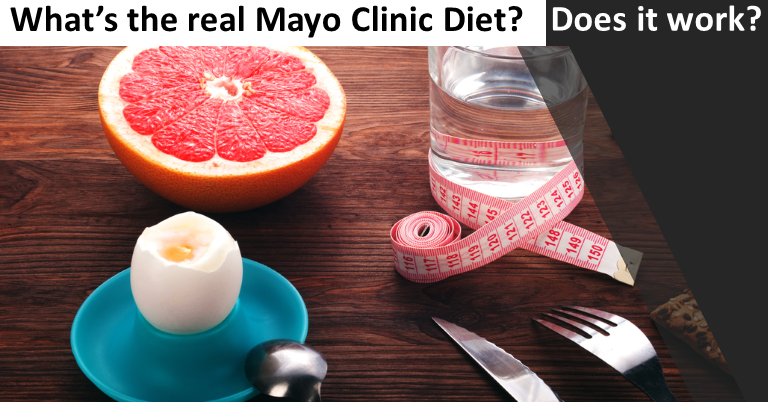What’s the real Mayo Clinic Diet, and does it work?
M3 Global Newsdesk Aug 03, 2019
Imagine a high-fat, low-carb diet, rich in grapefruit, with the power to burn off fat and make you lose 50 pounds or more in just 10 weeks. Does it sound too good to be true? It is.

For years, this scientifically bogus fad diet was promoted as the “Mayo Clinic Diet,” even though it was not related to the Mayo Clinic at all.
In response, the Mayo Clinic developed its own official Mayo Clinic Diet, which is detailed in the Mayo Clinic Diet book.
The real Mayo Clinic Diet is a long-term weight-management program developed by weight-loss specialists at the Mayo Clinic, Rochester, MN. It is designed to reshape the lifestyle of the adherent by promoting the adoption of healthy new habits and doing away with unhealthy ones. The goal of the diet is to make a smooth, easy, and enjoyable transition to a healthy weight that can be maintained throughout life.
Behavior change
The Mayo Clinic Diet centers on encouraging positive dietary behavior changes, including routine exercise (30 minutes per day), consumption of more fruits and veggies, not snacking while watching television, adherence to the Mayo Clinic Healthy Weight Pyramid, finding your inner weight-loss motivation, setting achievable goals, and dealing with setbacks.
“Like many weight loss programs, this diet focuses on balancing food and physical activity choices to promote weight loss,” said Isabel Maples, MEd, RDN, a spokesperson for the Academy of Nutrition and Dietetics, in an exclusive interview with MDLinx. “However, it’s the behavioral component that sets this type of program apart. Week by week, participants examine why they make the choices they do, as well as how to change those unhealthy behaviors, one at a time.”
She continued, “So often, dieters blame themselves when they can’t stick to a diet. But the Mayo Diet shows participants how to channel their desire to lose weight into reacting differently to internal and environmental cues that constantly scream, ‘Eat more!’”
Diet change
According to the Mayo Clinic: “The Mayo Clinic Diet doesn't require you to be precise about counting calories or grams of fat. Instead, the Mayo Clinic Healthy Weight Pyramid serves as a guide to making smart eating choices. The main message is simple: Eat most of your food from the groups at the base of the pyramid and less from the top—and move more.”
Ascending the pyramid, from base (most) to the apex (least), foods include:
- Fruits/veggies
- Carbs
- Protein/dairy
- Fats
- Sweets
In other words, dieters should eat greater amounts of fruits and veggies and limit their consumption of sweets (no more than 75 calories/day).
The throughline of the Mayo Clinic Diet involves consuming low-energy-dense foods to promote satiety on fewer calories. With respect to the rest of the other food groups in the pyramid, moderation is key and food choices should include whole-grain carbs, lean protein sources (eg, legumes, low-fat dairy, and fish), and unsaturated fats, which are good for the heart. No foods need to be eliminated altogether.
Caloric intake varies according to sex and starting weight, and the Mayo Clinic Diet offers several calorie levels based on dieter goals. Here are the general components of a 1,200-calorie menu per the Mayo Clinic:
- 3 servings of fruit
- 4 or more servings of vegetables
- 4 servings of beneficial carbs (eg, whole grains)
- 3 servings of healthy fats
- 3 servings of lean protein or low-fat dairy
Phases
The initial 2-week phase is called “Lose It!” and is intended to trigger the metabolism by breaking ingrained, bad diet habits and creating several new ones. Mayo experts estimate that weight loss is 6-10 pounds during the “Lose It!” phase, as the dieter starts exercising.
The second phase, “Live It,” is intended to last a lifetime. It concentrates on portion sizes, food choices, menu planning, exercise, and adherence to healthy habits. During this phase, the dieter may lose up to 2 pounds weekly until they achieve their goal weight.
In addition to weight loss and long-term weight management, the Mayo Clinic Diet may have secondary health benefits, including protection against diabetes, heart disease, high blood pressure, high cholesterol, sleep apnea, and premature mortality.
Keep at it
Maples cautioned that behavior change during the phases can be challenging.
“When adopting a new behavior or giving up an old one, practice makes perfect. Setbacks happen; expect them. Success comes instead from persevering through setbacks…from pushing through when the weight is not coming off like you want. It’s figuring out how to burn more calories than you’re taking in, while also eating enough to satisfy both your body and your soul,” she said.
“Long-term success with weight loss means getting out of your comfort zone initially but then developing new comfort zones,” Maples added. “How we eat is driven by so many factors, including hunger, health, self-esteem, culture, time, and socialization. A successful program is one that incorporates all of those driving factors but still allows us to reach a healthy weight.”
This story is contributed by Naveed Saleh and is a part of our Global Content Initiative, where we feature selected stories from our Global network which we believe would be most useful and informative to our doctor members.
-
Exclusive Write-ups & Webinars by KOLs
-
Daily Quiz by specialty
-
Paid Market Research Surveys
-
Case discussions, News & Journals' summaries